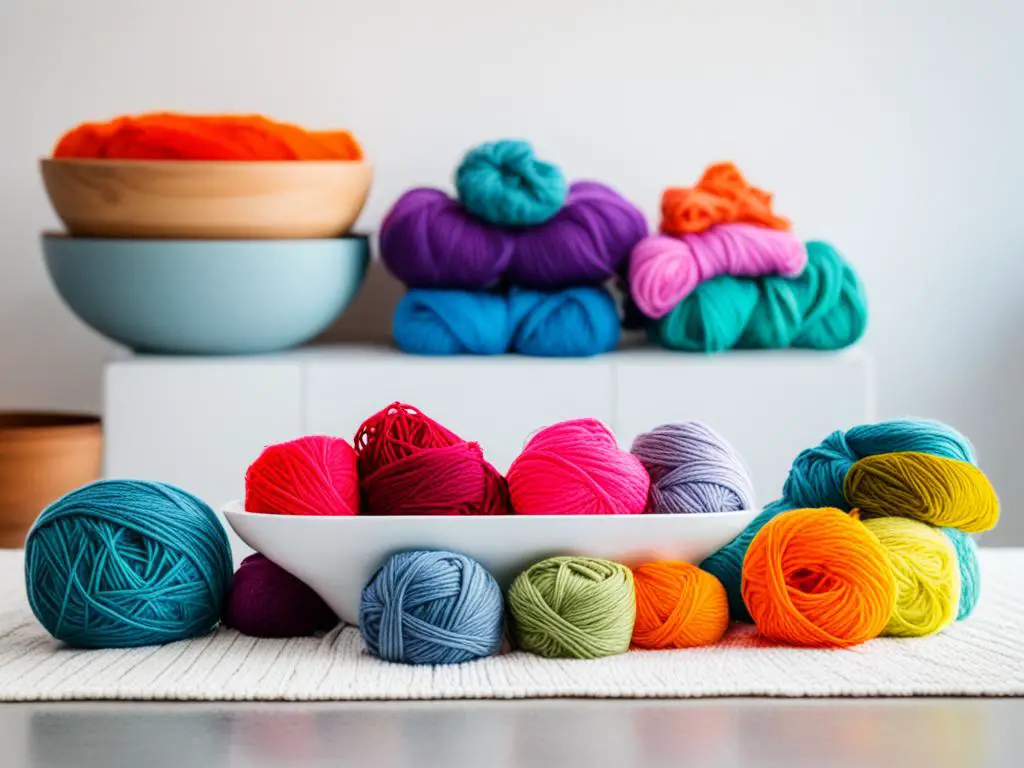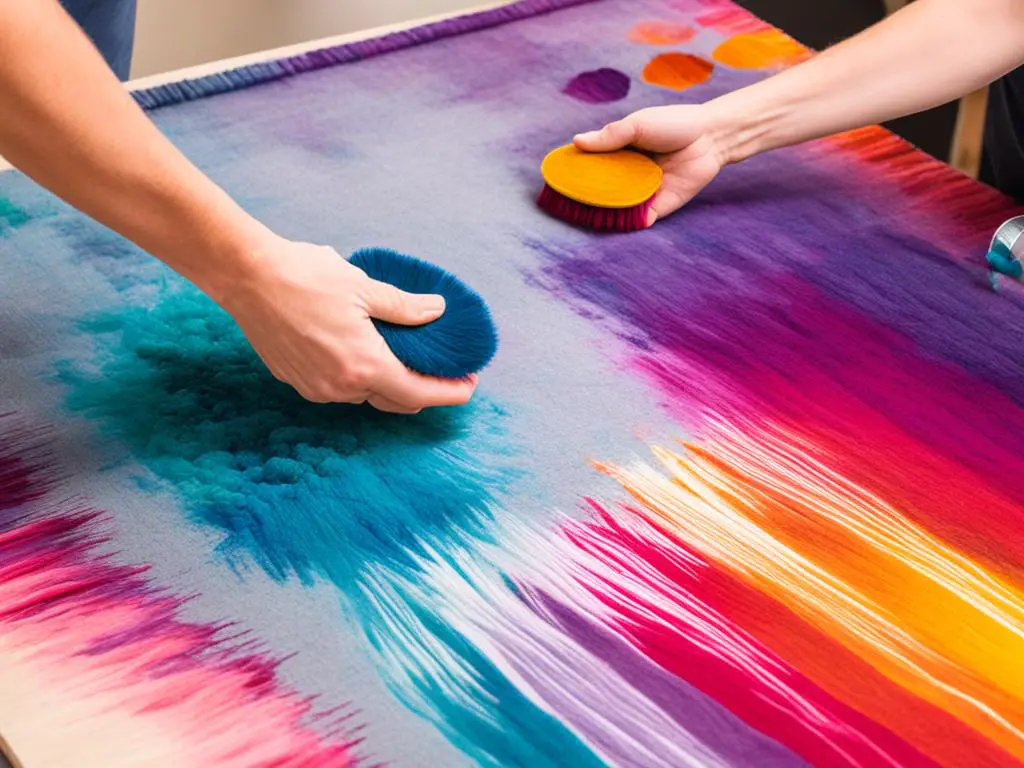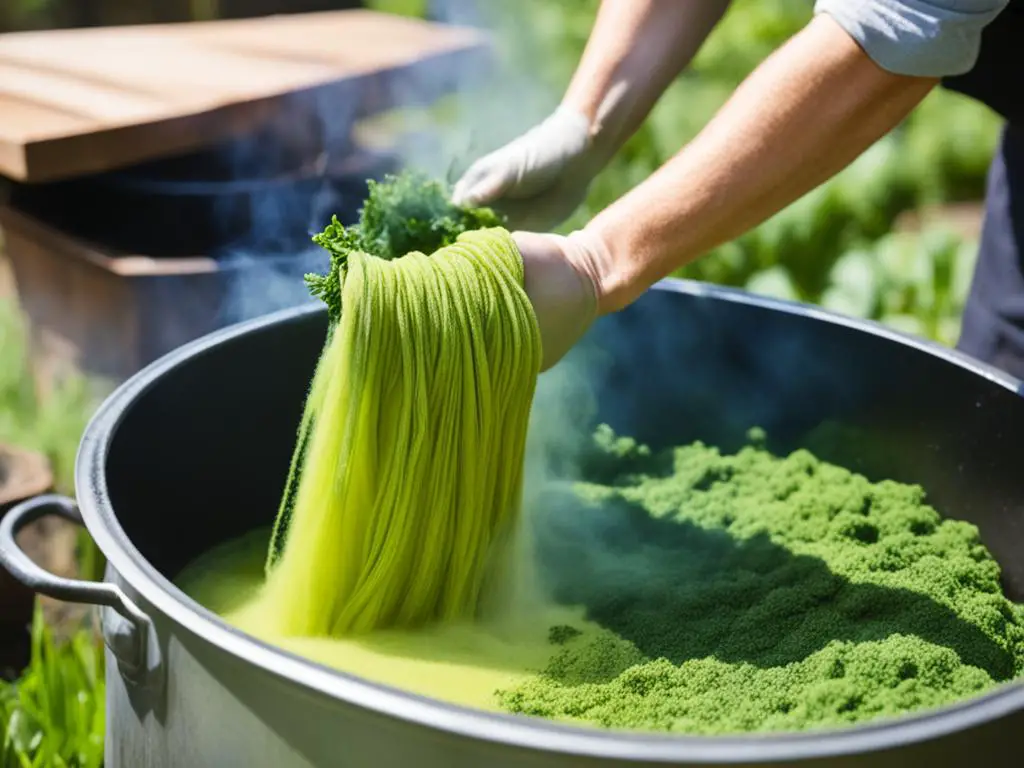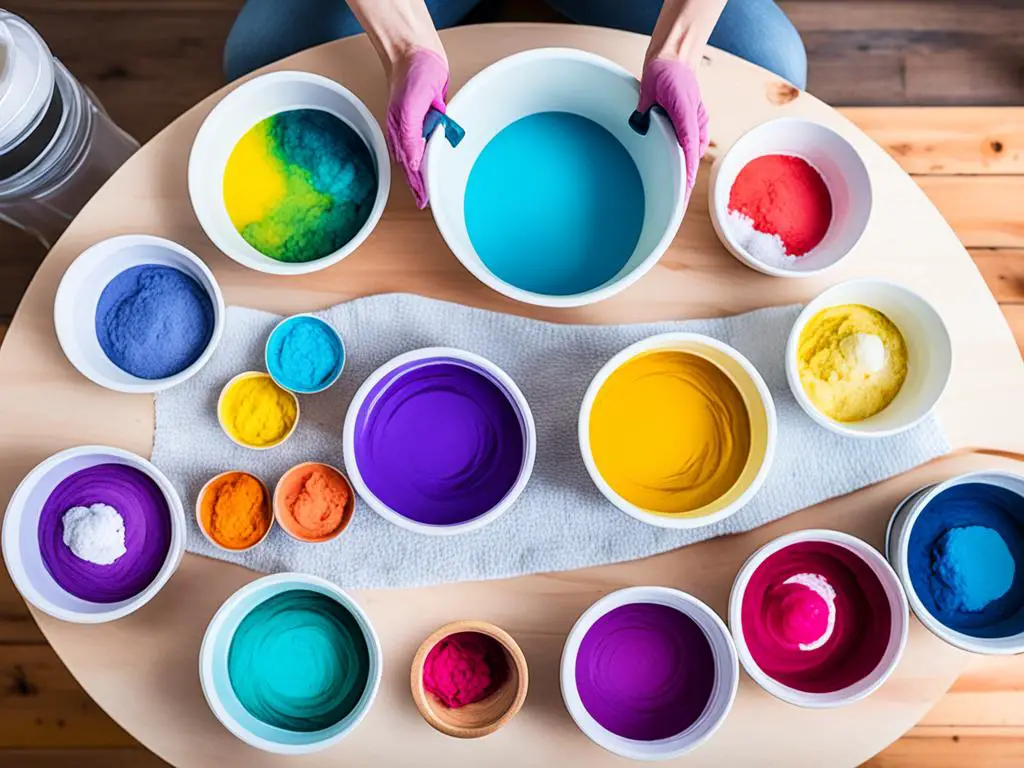Dyeing a rug at home is a cost-effective way to revitalize your space and give your old rug a new life. With the right techniques and materials, you can easily dye your rug to match your desired color palette. In this DIY guide, we will walk you through the step-by-step process of dyeing a rug at home. We will cover rug dyeing techniques, materials needed, and tips for a successful rug coloring process. So grab your supplies and get ready to transform your rug with our easy DIY method.
Key Takeaways:
- DIY rug dyeing is a cost-effective way to revitalize your space.
- Choose an old rug made of natural fibers like wool or cotton for best results.
- Materials needed for rug dyeing include liquid dye, spray bottles, sponge, gloves, water hose, and vacuum.
- Follow the step-by-step guide to ensure a successful rug dyeing process.
- Customize your rug to match your unique style and home decor.
Materials Needed for Rug Dyeing
To dye your rug at home, you will need a few essential materials. These include:
- Old rug (preferably made of natural fibers like wool or cotton)
- Liquid dye (such as Rit)
- Spray bottles
- Sponge
- Rubber gloves
- Water hose
- Vacuum
These materials will help you achieve a successful dyeing process and ensure that your rug absorbs the dye evenly. While professional rug dyeing services are also an option, dyeing your rug at home allows for a more personalized touch and cost savings.

Materials Needed for Rug Dyeing
| Materials |
|---|
| Old rug (preferably made of natural fibers like wool or cotton) |
| Liquid dye (such as Rit) |
| Spray bottles |
| Sponge |
| Rubber gloves |
| Water hose |
| Vacuum |
Step-by-Step Guide to Dyeing a Rug
Are you ready to transform your old rug into a vibrant centerpiece for your home? Follow these easy steps to dye your rug at home and achieve stunning results:
Step 1: Preparing your rug
Start by thoroughly cleaning your rug to remove any dirt or stains. Use a vacuum cleaner to remove loose debris, and then spot clean any stubborn stains. Ensure that your rug is completely dry before proceeding to the next step.
Step 2: Choosing the right dye
Select a dye that is suitable for the material of your rug. For natural fibers like wool or cotton, opt for a fabric dye specifically formulated for these materials. Read the instructions on the dye packaging carefully to determine the amount of dye needed for your rug size.
Step 3: Mixing the dye
Follow the instructions on the dye packaging to mix the dye solution. Wear gloves to protect your hands and carefully mix the dye and any required additives in a large container. Make sure to blend the dye thoroughly to ensure even color distribution.
Step 4: Applying the dye
There are several methods you can use to apply the dye to your rug:
- Spray bottle method: Fill a spray bottle with the dye solution and evenly spray it onto the rug’s surface, working in small sections. Use a sponge or brush to spread the dye and ensure even coverage.
- Immersing method: If your rug is small enough, you can immerse it in a large container filled with the dye solution. Use your hands or a stick to agitate the rug gently, ensuring all fibers are saturated with the dye.
Step 5: Allowing the dye to set
Once you have applied the dye, allow it to set according to the manufacturer’s instructions. This typically involves letting the dye penetrate the fibers for a specific amount of time. Keep the rug in a well-ventilated area during this process.
Step 6: Rinsing and drying
Rinse the rug thoroughly with clean water to remove any excess dye. Use a hose or bathtub to rinse the rug until the water runs clear. Allow the rug to dry completely in a shaded area, away from direct sunlight, to prevent color fading.

Step 7: Finishing touches
Once your rug is dry, vacuum it to remove any loose fibers and fluff up the pile. If needed, you can use a fabric protectant spray to enhance the rug’s durability and preserve the color for longer. Your newly dyed rug is now ready to be placed in your desired location, adding a pop of color to your space.
Remember, the best rug dyeing methods may vary depending on the type of rug you have and the dye you choose. It’s always a good idea to test the dye on a small, inconspicuous area of the rug before proceeding with the entire dyeing process.
Tips for Successful Rug Dyeing
When it comes to dyeing a rug at home, using natural methods and adopting the best techniques is key to achieving stunning results. Here are some expert tips to help you successfully dye your rug:
1. Choose Natural Rug Dyeing Techniques
Opt for natural rug dyeing techniques to ensure a sustainable and eco-friendly process. Natural dyes, such as plant-based dyes extracted from flowers, roots, and leaves, can create beautiful and long-lasting colors. Explore different natural dye options like indigo, turmeric, or madder root to add unique hues to your rug.
2. Test the Dye on a Small Area
Prior to dyeing the entire rug, it’s crucial to test the dye on a small, inconspicuous area. This will help you assess the color intensity and ensure that it suits your desired outcome. Additionally, testing the dye will allow you to make any necessary adjustments before applying it to the entire rug.
3. Prepare the Rug for Dyeing
Properly preparing the rug is essential for an even dye application. Thoroughly clean the rug by vacuuming it to remove any dirt or debris. If the rug is heavily soiled, consider washing it before starting the dyeing process. Additionally, protect the areas of the rug that you don’t want to dye by covering them with tape or plastic sheets.
4. Follow the Instructions Carefully
Whether you are using a liquid dye, powder dye, or natural dye extract, it’s crucial to carefully follow the instructions provided. Different dye brands and types may have specific application methods and recommended proportions. Adhering to the instructions will help you achieve the desired color and prevent any mishaps during the dyeing process.
5. Apply the Dye Evenly
Evenly applying the dye is crucial for achieving a uniform color on your rug. Use a spray bottle or sponge to apply the dye, ensuring that you cover all areas evenly. Take your time to work the dye into the rug’s fibers, ensuring a thorough and consistent application.
6. Allow Sufficient Dyeing Time
After applying the dye, allow sufficient time for it to penetrate and bond with the rug fibers. Follow the recommended dyeing time stated in the instructions, as this can vary depending on the dye type and rug material. Giving the dye enough time will ensure that the color sets properly.
7. Rinse and Dry the Rug
Once the dyeing time is complete, rinse the rug thoroughly to remove any excess dye. Use a water hose or bathtub to rinse the rug until the water runs clear. After rinsing, carefully squeeze out any excess water and hang the rug to dry in a well-ventilated area. Avoid direct sunlight, as it may cause the colors to fade.
8. Protect and Maintain the Dyed Rug
To ensure the longevity of your dyed rug, take steps to protect and maintain it. Avoid placing the rug in high-traffic areas, as this can cause premature wear and fading of the colors. Regularly vacuum the rug to remove any dirt or debris, and consider placing a rug pad underneath to add cushioning and prevent slipping.
Follow these tips to achieve successful rug dyeing results and enjoy the beauty of your transformed rug. Get creative with natural rug dyeing techniques and explore an array of colors to add a unique touch to your living space.

Conclusion
Dyeing a rug at home is a fun and creative DIY project that allows you to give your space a fresh new look on a budget. By following the step-by-step guide and utilizing the best rug dyeing methods, you can easily transform your old rug into a personalized masterpiece.
With DIY rug dyeing, you have the freedom to choose from a wide range of colors and effects, whether you prefer bold and vibrant hues or subtle ombre shades. This allows you to create a rug that perfectly complements your unique style and home decor.
Remember to carefully select the right materials for rug dyeing, such as liquid dye and spray bottles, to ensure an even and long-lasting color application. Additionally, following the provided tips for a successful rug dyeing process will help you achieve professional-looking results.
So, why not unleash your creativity and embark on a DIY rug dyeing project? With a little time and effort, you can breathe new life into your rug and transform your space with a beautiful and customized centerpiece.



